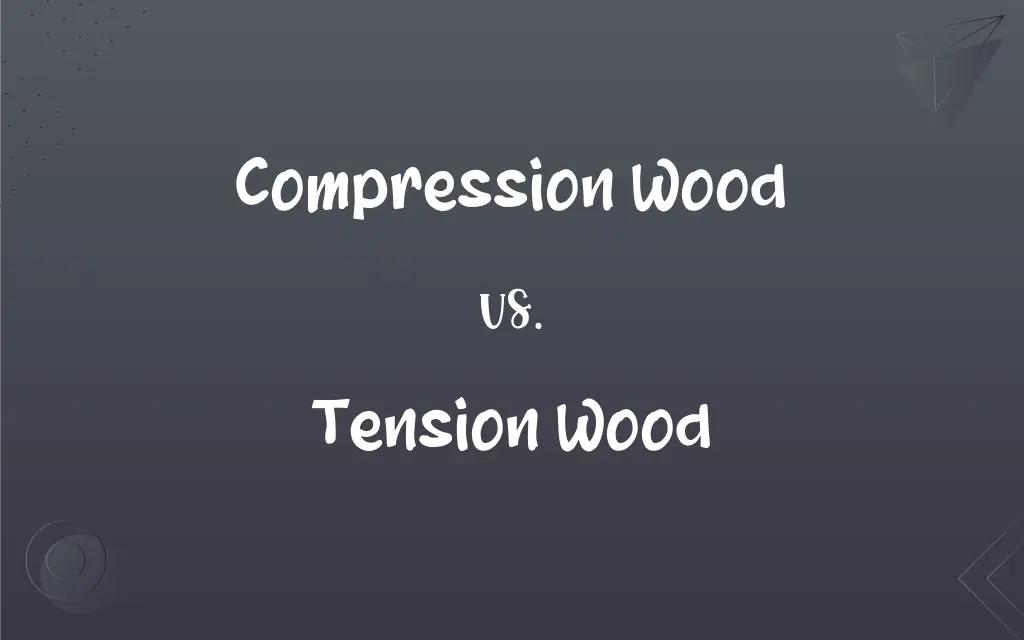Compression Wood vs. Tension Wood: What's the Difference?
Edited by Janet White || By Harlon Moss || Updated on October 11, 2023
Compression wood forms on the underside of conifer branches to resist gravity, while tension wood forms on the upper side of hardwood branches to pull branches upward.

Key Differences
Compression wood is a specialized type of wood formed on the underside of branches or leaning stems of conifers. On the other hand, tension wood is a type of wood that develops on the upper side of branches or leaning stems of hardwoods.
Both compression wood and tension wood are reaction woods, meaning they develop in trees as a response to environmental stress. However, compression wood is typically denser, while tension wood has a more gelatinous layer, often referred to as G-layer.
Trees form compression wood to help counteract gravitational forces, ensuring they maintain their desired growth direction. Tension wood, on the other hand, aims to pull branches and stems back towards the light or their vertical position.
Compression wood often appears darker and is harder than normal wood. In contrast, tension wood is usually lighter in color and can be difficult to identify without microscopic examination due to its thin G-layer.
In the timber industry, both compression wood and tension wood can cause challenges. Compression wood tends to shrink excessively upon drying, whereas tension wood may lead to warping of lumber products.
ADVERTISEMENT
Comparison Chart
Formation Location
Forms on the underside of branches.
Forms on the upper side of branches.
Tree Type
Found in conifers.
Found in hardwoods.
Purpose
Resists gravitational forces.
Pulls branches back towards the light or verticality.
Appearance
Darker, denser than normal wood.
Lighter with a gelatinous G-layer.
Effect on Timber
Can cause excessive shrinkage when drying.
Can lead to warping of lumber products.
ADVERTISEMENT
Compression Wood and Tension Wood Definitions
Compression Wood
Wood that helps conifers maintain their desired growth direction.
Without compression wood, many conifers would have a hard time growing straight.
Tension Wood
Hardwood's response to environmental stress aiming to correct growth direction.
The tree had formed tension wood to correct the direction of its leaning branch.
Compression Wood
Coniferous wood that is harder than normal due to its specialized formation.
The excessive hardness of the board was due to the presence of compression wood.
Tension Wood
Reaction wood in hardwoods, formed to pull branches towards light or verticality.
The oak's branch exhibited tension wood, indicating its effort to grow towards the sunlight.
Compression Wood
A type of reaction wood in conifers formed to combat gravitational forces.
The branch had a thick layer of compression wood, indicating the tree's struggle with gravity.
Tension Wood
Wood with a thin, gelatinous G-layer found on the upper side of hardwood branches.
Tension wood is often identified microscopically because of its unique G-layer.
Compression Wood
A wood type resulting from environmental stress in conifers.
The leaning pine had developed a significant amount of compression wood.
Tension Wood
A wood type that can cause warping in lumber products.
Lumber mills check for tension wood to ensure the quality of their products.
Compression Wood
The denser, darker wood found on the underside of conifer branches.
Lumber with a lot of compression wood is prone to excessive shrinkage.
Tension Wood
Light-colored wood in hardwoods, formed as a reaction to external challenges.
The pale sections of the plank were identified as tension wood.
FAQs
Is tension wood lighter or darker than regular wood?
Tension wood is typically lighter in color than regular wood.
What is compression wood?
Compression wood is a reaction wood formed on the underside of conifer branches to combat gravitational forces.
Where is tension wood found?
Tension wood is found on the upper side of hardwood branches.
Are both compression wood and tension wood types of reaction wood?
Yes, both are formed in response to environmental stress.
Which type of tree, conifer or hardwood, produces tension wood?
Hardwoods produce tension wood.
Is compression wood harder than normal wood?
Yes, compression wood is typically denser and harder.
Why do trees form compression wood?
Trees form compression wood to counteract gravitational forces and maintain their desired growth direction.
Can tension wood be easily identified without a microscope?
While tension wood is often lighter, its thin G-layer makes it hard to identify without microscopic examination.
Is compression wood common in leaning conifer trees?
Yes, leaning conifers often form compression wood to combat the effects of gravity.
Does tension wood have any advantages for the tree?
Yes, tension wood helps the tree correct its growth direction, pulling branches towards light or verticality.
What makes tension wood unique microscopically?
Tension wood often has a gelatinous layer called the G-layer.
Do all conifers produce compression wood?
While not all conifers will produce compression wood, they have the capability to do so under specific stresses.
Do hardwoods like oak and maple form tension wood?
Yes, hardwoods such as oak and maple can form tension wood in response to environmental stress.
How can I identify compression wood in a lumber piece?
Compression wood is denser and darker than the surrounding wood.
What's the main challenge with tension wood in timber?
Tension wood can lead to warping of lumber products.
What's the purpose of tension wood in a tree?
To pull branches back towards the light or their vertical position.
Is compression wood beneficial for the tree?
Yes, it helps the tree maintain its desired growth direction against gravitational forces.
How does compression wood differ in appearance from normal wood?
Compression wood is darker and denser than normal wood.
How does tension wood affect the quality of timber products?
Tension wood may lead to warping, affecting the product's quality.
Can compression wood be used in the lumber industry?
Yes, but it can cause excessive shrinkage upon drying.
About Author
Written by
Harlon MossHarlon is a seasoned quality moderator and accomplished content writer for Difference Wiki. An alumnus of the prestigious University of California, he earned his degree in Computer Science. Leveraging his academic background, Harlon brings a meticulous and informed perspective to his work, ensuring content accuracy and excellence.
Edited by
Janet WhiteJanet White has been an esteemed writer and blogger for Difference Wiki. Holding a Master's degree in Science and Medical Journalism from the prestigious Boston University, she has consistently demonstrated her expertise and passion for her field. When she's not immersed in her work, Janet relishes her time exercising, delving into a good book, and cherishing moments with friends and family.































































